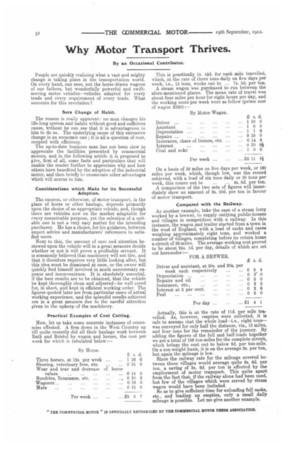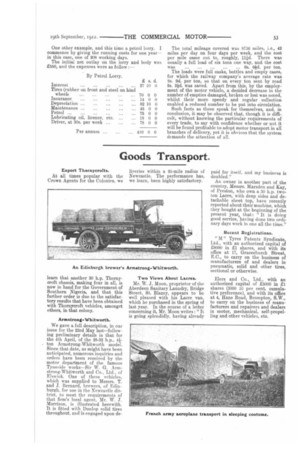Why Motor Transport Thrives.
Page 12

Page 13

If you've noticed an error in this article please click here to report it so we can fix it.
By an Occasional Contributor.
People are quickly realizing what a vast and mighty change is taking place in the transportation world. On every hand, one sees, not the horse-drawn wa..gons of our fathers, but wonderfully powerful and swiftmoving motor vehicles—vehicles adapted for every trade and every requirement of every trade. What accounts for this revolution '1
Sure Change of Habit.
The reason is really apparent : no man changes his life-long system and habits without good and sufficient cause, without he can see that it is advantageous to him to do so. The underlying cause of this extensive change is an economic one ; it is all a question of cost, coupled with efficiency. The up-to-date business man has not been slow to appreciate the facilities, presented by commercial motors, and in the following article it is proposed to give, first of all, some facts and particulars that will enable the reader further to appreciate why and how others have benefited by the adoption of the industrial motor, and then briefly to enumerate other advantages which will accrue to him.
Considerations which Make for its Successful Adoption.
The success, or otherwise, of motor transport, in the place of horse or other haulage, depends primarily upon the choice of an appropriate vehicle, and, though there are vehicles now on the market adaptable for every conceivable purpose, yet the selection of a suitable one is not a very easy matter for the intending purchaser. He has a choice, for his guidance, between expert advice and manufacturers' references to satisfied users.
Next to this, the amount of care and attention bestowed upon the vehicle will in a great measure decide whether or not it will prove a profitable servant. It is commonly believed that machinery will not tire, and that it therefore requires very little looking after, but this idea must be dismissed at once, or the owner will quickly find himself involved in much unnecessary expense and inconvenience. It is absolutely essential, if the best results are to be obtained, that the vehicle be kept thoroughly clean and adjusted—be well cared for, in short, and kept in efficient working order. The figures quoted later are from particular cases of actual working experience, and the splendid results achieved are in a great measure due to the careful attention given to the upkeep of the machinery.
Practical Examples of Cost Cutting.
Now, let us take some concrete instances of economies erected. A firm down in the West Country up till quite recently did all their haulage work between Bath and Bristol by wagon and horses, the cost per week for which is tabulated below : This is practically 1s. 44d. for each mile travelled, which, at the rate of three tons daily on five days per week, i.e., 15 tons, works out to ... 7s. 3d. per ton. A steam wagon was purchased to run between the afore-mentioned places. The mean rate of travel was about four miles per hour for eight hours per day, and the working costs per week were as follow (prime cost of wagon £550:— On a basis of 32 miles on five days per week, or 160 miles per week, which, though low, was the record achieved, with a load of six tons daily or 30 tons per
week, this comes out to ... 4s. 5d. per ton. A comparison of the two sets of figures will immediately show an amount of 2s. 10d. per ton in favour of motor transport.
Compared with the Railway.
As another example, take the case of a steam lorry worked by a brewer, to supply outlying public-houses and villages in competition with a railway. In this instance, the wagon and trailer started from a town in the west of England, with a load of casks and cases weighing approximately eight tons, and worked a number of villages, completing before its return home a, circuit of 26 miles. The average working cost proved to be about 24s. Id. per day, details of which are set
out hereunder :
Actually, this is at the rate of 11d, per mile tr-. yelled. As, however, empties were collected, it is safe to assume that the whole load—i.e., eight tons— was conveyed for only half the distance, viz., 13 miles, and four tons for the remainder of the journey. By adding the figures of the full and half-loads together we get a total of 156 ton-miles for the complete circuit, which brings the cost out to below 2d, per ton-mile. On a ton-weight basis, it is on. the average 3s. per ton, but again the mileage is low. Since the railway rate for the mileage covered between these villages would average quite 6s. 6d. per ton, a saving of 3s. 6d. per ton is effected by the employment of motor transport. This quite apart from the fact that, if the railway alone had been used, but few of the villages which were served by steam wagon would have been included. So as to give sufficient time for unloading full casks, etc., and loading up empties, only a small daily mileage is possible. Let me give another example.
One other example, and this time a petrol lorry. I commence by giving the running costs for one year-in this case, one of 208 working days. The initial net outlay on the lorry and body was 2550, and the expenses were as follow
The total mileage covered was 8736 miles, i.e., 42 miles per day on four days per week, and the cost per mile came out to, roughly, hId. There was usually a full load of six tons one way, and the cost was 6s. od. per ton.
The loads were full casks, bottles and empty cases, for which the railway company's average rate was Be. 9d. per ton, so that on every ton sent by road Be. 20. was saved. Apart from this, by the employment of the motor vehicle, a decided decrease in the number of empties damaged, broken or lost was noted, whilst their more speedy and regular collection enabled a reduced number to be put into circulation.
Such facts as these speak for themselves, and, in conclusion, it may be observed that, though it is difficult, without knowing the particular requirements of every trade, to say with confidence whether or not it will be found profitable to adopt motor transport in all branches of delivery, yet it is obvious that the system demands the attention of all.






















